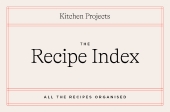
 2
2




 2
2




Learning slowly...
How permies.com works
 1
1




 1
1




Invasive plants are Earth's way of insisting we notice her medicines. Stephen Herrod Buhner
Everyone learns what works by learning what doesn't work. Stephen Herrod Buhner
 1
1




 1
1




Muffin & whole grain pancake blend:
1 cup Tapioca starch
1 cup sorghum flour
1 cup teff flour
1/4 cup ground chia
(feel free to replace up to 1/4 cup of sorghum flour with a nut flour or bean flour, mesquite flour is especially delicious in pancakes)
use 1 to 1 with 3 cups of all purpose flour in your typical recipes.
Flatbread mix:
2 cups amaranth flour
1 cup tapioca starch
mix with about 1 cup water and a tablespoon or two of oil to make a simple dough. Salt to taste, a little instant yeast if you want. I often add herbs, cumin seeds, dried onion flakes, things like that. Bakes in about 15-18 minutes at 425, makes an easy bread to dip in soups, or top with anything. Arrowroot starch instead of tapioca starch will make a softer bread, tapioca is chewier.
Amaranth needs no binders, making it really easy to work with, but it gets really grassy and stodgy (read: not good at all) if it gets very wet. Amaranth flour does not make good pancakes or muffins in my opinion.
Cookie mix:
1 cup millet flour
1 cup tapioca starch
1 cup almond flour
1/4 cup chia seed
This is a favourite mix of mine for cookies. The millet is so pleasant in flavour but it makes a really really delicate crumb so it needs a lot of binding power. A chewy cookie is the perfect place to showcase it.
 1
1




James Alun wrote:So mum gets Dove flour which uses a blend of rice, potato, tapioca, maize, buckwheat and xanthum apparently.
James Alun wrote: I've found it works well for sponges (almost the same as wheat flour), it's ok for crumble (it needs more butter and the texture is wrong but the flavour is ok) and terrible for cookies (no structure at all).




Jan White wrote:I'm completely in love with chickpea flour. I don't have an oven, so I make pancakes and use those for bread. They're usually 100% chickpea, cause it holds together the best and has the breadiest texture of the flours I've tried. You have to eat them right away or they get sooooo sry, though!
Millet flour has a really nice texture and mild taste, but it doesn't hold together as well as chickpea. I often mix chickpea or oat flour in with other flours to keep them from being as crumbly.
Take a look at www.powerhungry.com She's got lots of gluten free baking recipes, most with very few ingredients. I've made a few of her things and liked them all.
 1
1





|
What a stench! Central nervous system shutting down. Save yourself tiny ad!
The new gardening playing cards kickstarter is now live!
https://www.kickstarter.com/projects/paulwheaton/garden-cards
|









